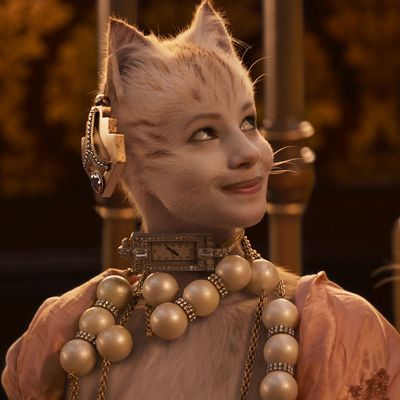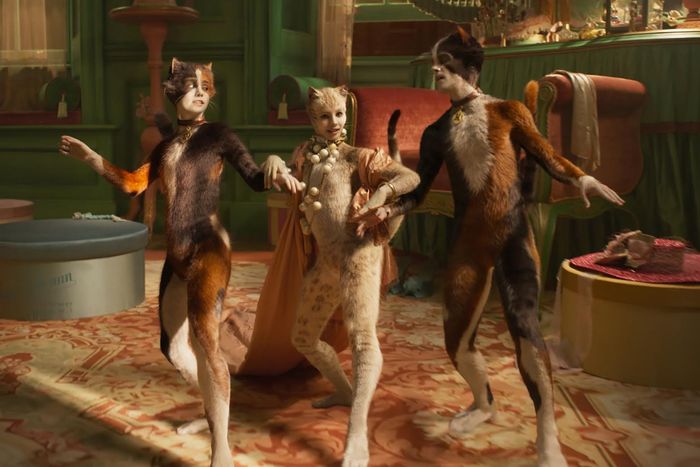
At a recent, sold-out “Meowdy” screening at Alamo Drafthouse Cinema in Los Angeles, a crowd of Cats lovers lapped up milk-based cocktails with names like Purr and Hiss out of specialized saucers. Some of them dressed to cosplay: They wore faux whiskers, cat-paw gloves, fuzzy tails, and sequined cat ears. Others carried props: cardboard Grumpy Cat masks or confetti poppers they planned to detonate at the onscreen arrival of their favorite characters. More than a few people were drunk or high, and nearly everyone had left human inhibitions at the door regardless — likely primed by the theater’s Jellicle Ball Karaoke Challenge, audience members would soon shout-sing along with the stupefying morass projected onscreen. Not exactly the kind of fan gathering one might expect for an unmitigated cinematic disaster now regarded as one of last year’s biggest flops.
Released in mid-December, the $100 million movie adaptation of Andrew Lloyd Webber’s epochal stage musical — featuring a grab bag of pop-culture figures: Taylor Swift, James Corden, Jennifer Hudson, Jason Derulo, Idris Elba, all as singing, prancing “Jellicle” cats — seemed to expend its nine lives both commercially and critically. The film grossed a mere $6.5 million in North America over its opening weekend after critics effectively showered it with kitty litter, combining to generate arguably the loudest din of social-media Schadenfreude of any title on the 2019 release calendar. Worse still, around Christmas, a make-or-break corridor in the awards season, Cats’ distributor, Universal, yanked the title from its For Your Consideration web page and quietly removed the film from a streaming platform for members of the Academy of Motion Picture Arts and Sciences — the clearest indications the studio had lost all faith that the Tom Hooper–directed tale had even the remotest hope of qualifying for an Oscar run.
But a funny thing happened on the way to the cinematic scratching post. Word-of-mouth buzz began to build that Cats’ numerous and not-inconsiderable quirks were, in fact, more fun than the sum of its filmmaker- and studio-intended entertainment value. In turn, a relatively small but determined resistance force began to build — an audience that grew not because Swift’s song “Beautiful Ghosts” had been nominated for a Golden Globe, but specifically to revel in the spectacle of Cats’ defiant awfulness. (Drugs certainly help these revelers; a recent Washington Post story chronicles an uptick in people seeing Cats while “high out of their minds.”) They seemed to relish the collective joy of discovering a movie this bizarre in an era when Hollywood has never been more allergic to creative risk-taking. Repeat viewings became de rigueur.
“Cats is like an experience where everyone walks in as strangers but leaves as family,” says Abel Charrow, a Los Angeles–based marketing event planner who has seen the movie twice, both times with boisterous groups of friends. “Because the experience is so weird that it’s unifying. An entire room of people goes through that experience and then we’re looking at each other and nodding and sharing knowing smiles of like, ‘That was crazy.’”
Cats’ theatrical distribution has dwindled from a high of 3,380 screens upon initial release to fewer than 150 by the last weekend in January. Having grossed just $65 million worldwide to date, the film would need to haul in at least another $100 million to approach the break-even mark. It’s widely expected to net a theatrical loss of up to $100 million for Universal. Alamo Drafthouse Cinema, meanwhile, has become the first national theater chain to capitalize on Cats’ second-life groundswell of interest. On Friday, the Texas-based chain expanded the number of its theaters showing the film across the country, adding limited engagements in new locations including Brooklyn, Denver, Austin, Phoenix, Kansas City, San Antonio, Raleigh, North Carolina, and Springfield, Missouri.
Coming at a time when Cats has already faded into something of a pop-culture afterthought — notably absent from the movie’s December premiere, Corden joked, “I’ve heard it’s terrible”; Swift subsequently referred to Cats as “that weird-ass movie” — much of the current attention can be attributed to Alamo’s Rowdy Screening series. That is, partylike showings of movies such as Magic Mike XXL, Hustlers, and even the Ruth Bader Ginsburg documentary RBG, during which viewers are encouraged to arrive in costume and shout out and sing in spontaneous reaction to what they see on the screen (while still honoring the chain’s non-heckling code).
“All of our Rowdy screenings [for Cats] are sold out — the tickets are going like hotcakes,” says Rachel Walker, head of programming and creative at Alamo’s Los Angeles venue. Incentivizing that attendance, which anecdotal evidence indicates is increasingly comprised of repeat viewers: the secret menu of milk-based cocktails and the Jellicle Ball Karaoke Challenge, in which participants belt out songs with the word “cat” in their titles or engage in a knockout competition called Bombalurina Roulette (organized around Swift’s songbook). “We started with a couple of [nonmandatory] drinking games: Drink every time a cat introduces themselves, drink every time a cat is a little too sexual, and drink every time a cat magically vanishes to the purgatory barge,” she adds. “At certain screenings, people started yelling ‘Hands!’ every time human hands on the cats were visible. And sometimes they start chanting ‘Deut’ for Old Deuteronomy. Sometimes they chant ‘Dench’ when Judi Dench comes back on at the end. People are going crazy!”
Courtney Hoffman is one such attendee who found her enthusiasm surrounding Cats impossible to curb. The costume designer for films like Baby Driver and The Hateful Eight (who now has projects as a writer-director in development with J.J. Abrams’s Bad Robot Productions and Steven Spielberg’s Amblin Entertainment) block-booked tickets for a 35-person group to see Cats during an opening-weekend matinee. (This was before the movie was pulled from theaters and hastily reedited by Universal to reportedly add more refined visual effects.) The group “pregamed” at a friend’s nearby apartment, “because obviously, the No. 1 rule was no one can be sober,” she recalls.
“Everyone was just crying of laughter. And the number of times people just screamed, ‘What?!’ Like, ‘What’s happening?,’” Hoffman says. “I feel like if you were to see it without the ability to vocalize your confusion and excitement and horror, it would be too self-serious. From the second the movie starts, you feel like everything you know about reality is over. It’s just so truly baffling: How many great people said yes to it? How many people wrote checks for it? I was so entertained by the complexity. Why do they have shoes on? Why do the female cats have boobs? How did they get Idris Elba? There are just so many questions!”
Charrow, the director of experiential marketing for the cannabis-edibles company Kiva Confections, was a member of Hoffman’s party and subsequently organized his own eight-person excursion to see Cats a second time. He describes the vicarious thrill of observing his friends’ awed reactions to the movie, watching “their jaws drop” and realizing Cats “could have a second life almost like a curated experience.”
Alamo’s senior director of programming and promotions, Sarah Pitre, confirms that the shared audience experience of seeing Cats might serve as something of an antidote to streaming platforms’ continued disruption of theatrical moviegoing. “It captures that sense of wanting to enjoy something with fellow fans,” Pitre says. “That’s the way you want to enjoy [Cats] — not just staying at home. It’s more fun to come see this film that they love at the Alamo rather than watching it on your couch. Cats definitely is headed for Rocky Horror territory.” Upon that film’s 1975 theatrical debut, of course, the gender-bending musical-horror send-up was almost completely ignored by mainstream audiences, but later evolved into what critic Roger Ebert described as a “long-running social phenomenon.” Now a cult-movie classic, The Rocky Horror Picture Show has come to be seen by fanatical fans many, many times over at ritualized midnight showings where audience members throw hot dogs at the screen and call various cast members “asshole” and “slut” whenever they appear onscreen.
Charrow, however, feels Cats’ more kindred movie spirit may be Tommy Wiseau’s melodramatic schlock cinema masterwork The Room — a 2003 movie that grossed a barely consequential $1,800 over its theatrical run, yet developed a dedicated constituency that enjoys mocking its bonkers unintentional hilarity in repeat viewings years later. (In Charrow’s estimation, The Room — much like Cats — is “almost unwatchable if you just see it from beginning to end by yourself,” and is “bad and not as funny if you don’t interact with it.”
Further, he holds hope that the post-flop passion for Cats will inspire Hollywood to continue taking creative leaps. “There are so many weird choices in Cats, and I love them,” Charrow says. “I think I’ve unintentionally fallen into this position for being a proselytizer for the film, but it just makes me so happy that trashy things like this exist on such a grand scale. I would love to see this film actually succeed. And then the studio would say, ‘You know, maybe that wasn’t the worst mistake in the world. Let’s keep taking big risks.’”






